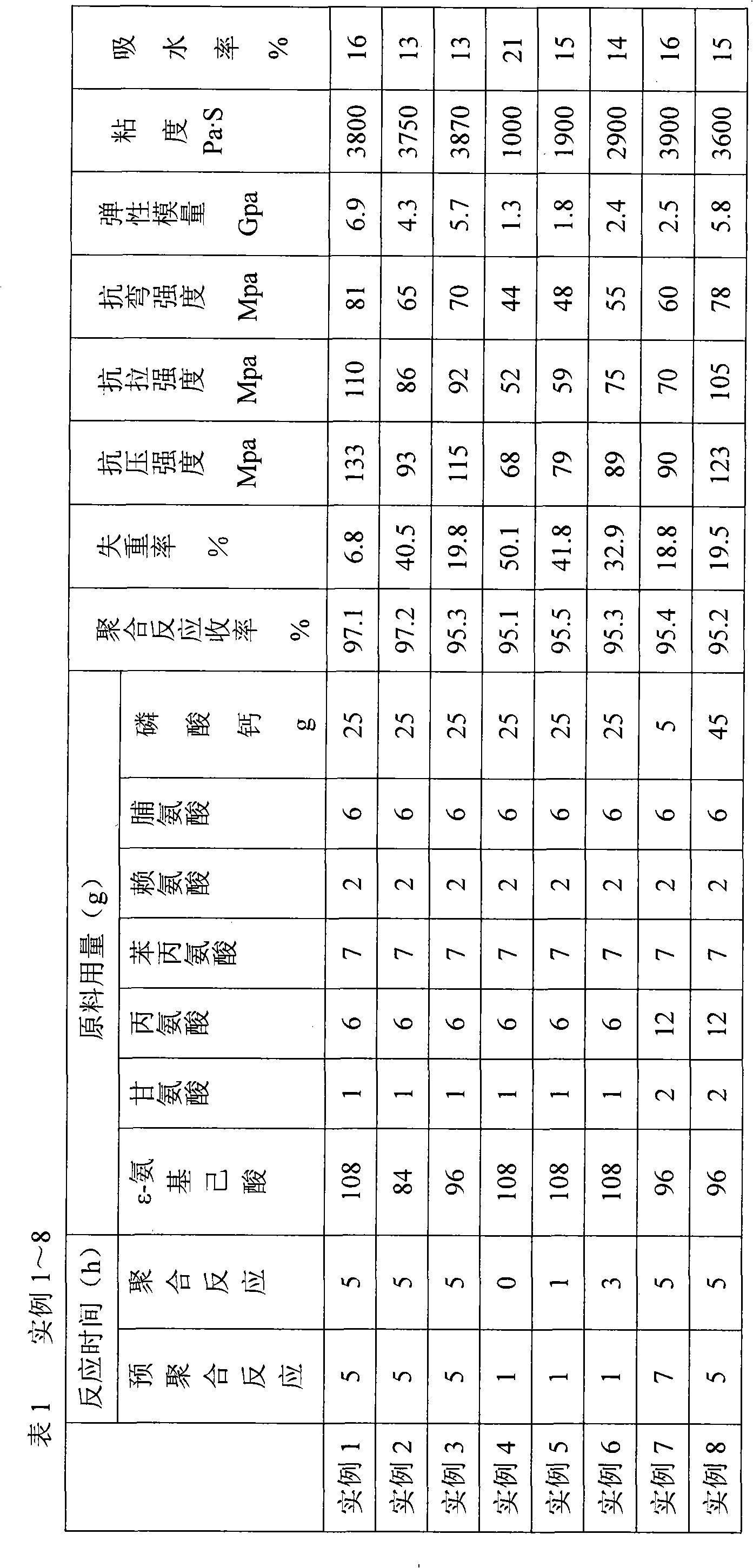Composite polymer bone-renovation material containing ceramic component and preparation method thereof
A technology of repairing materials and polymers, applied in medical science, prostheses, etc., can solve the problems of uncontrollable degradation rate of polylactic acid, insufficient mechanical properties of collagen, and limited use of materials to achieve excellent biomechanical properties and biological activity. Compatibility, good biological activity and compatibility, good hydrophilic effect
- Summary
- Abstract
- Description
- Claims
- Application Information
AI Technical Summary
Problems solved by technology
Method used
Image
Examples
example 1~8
[0025] The raw materials and dosages of phosphate, ε-aminocaproic acid, glycine, alanine, phenylalanine, lysine, proline and the like in each example are shown in Table 1 respectively. Put the raw materials into a 250ml three-necked bottle, add 100ml of water, and dehydrate at 200°C (you can judge whether the dehydration process has been completed by observing whether the amino acid starts to melt, etc.). After the dehydration is completed, the temperature is raised to 220°C for pre-polymerization in a molten state, and then the temperature is raised to 230°C to continue the polymerization reaction to obtain a degradable composite material. The time of the two steps of pre-polymerization and polymerization reaction, the yield of polymerization reaction and the corresponding mechanical performance indicators, and the weight loss rate of the obtained composite material after soaking in simulated body fluid for 12w are shown in Table 1, respectively.
example 9
[0027] Add 25g of HA, 105g of ε-aminocaproic acid, and 14g, 3g, and 5g of phenylalanine, glycine, and proline respectively into a 250ml three-neck flask, add 100ml of water, and dehydrate at 200°C. The dehydration is complete Afterwards, the temperature was raised to 220° C., and the melting reaction was carried out for 3 hours, and the temperature was further raised to 230° C. for 3 hours to obtain a degradable composite material with a yield of 96%. The obtained composite material has a viscosity of 3100Pa·S (240°C), a compressive strength of 106Mpa, a tensile strength of 96Mpa, a bending strength of 71Mpa, and an elastic modulus of 2.6Gpa; after soaking in simulated body fluid for 12w, the weight loss is 11.4%.
example 10
[0029] Add 25g of ADCP, 96g of ε-aminocaproic acid, 4g of glycine and 20g of lysine respectively into a 250ml three-neck bottle, add 100ml of water, dehydrate at 200°C, heat up to 220°C after dehydration, and melt the reaction After 3 hours, continue to heat up to 230° C. for 3 hours to obtain a degradable composite material with a yield of 97%. The viscosity of the polymer in the obtained composite material is 3200Pa·S (240°C), the compressive strength is 102Mpa, the tensile strength is 95Mpa, the bending strength is 60Mpa, and the elastic modulus is 2.6Gpa; after soaking in simulated body fluid for 12w, the weight loss is 15.4 %.
PUM
| Property | Measurement | Unit |
|---|---|---|
| Viscosity | aaaaa | aaaaa |
| Compressive strength | aaaaa | aaaaa |
| Tensile strength | aaaaa | aaaaa |
Abstract
Description
Claims
Application Information
 Login to View More
Login to View More - R&D
- Intellectual Property
- Life Sciences
- Materials
- Tech Scout
- Unparalleled Data Quality
- Higher Quality Content
- 60% Fewer Hallucinations
Browse by: Latest US Patents, China's latest patents, Technical Efficacy Thesaurus, Application Domain, Technology Topic, Popular Technical Reports.
© 2025 PatSnap. All rights reserved.Legal|Privacy policy|Modern Slavery Act Transparency Statement|Sitemap|About US| Contact US: help@patsnap.com



